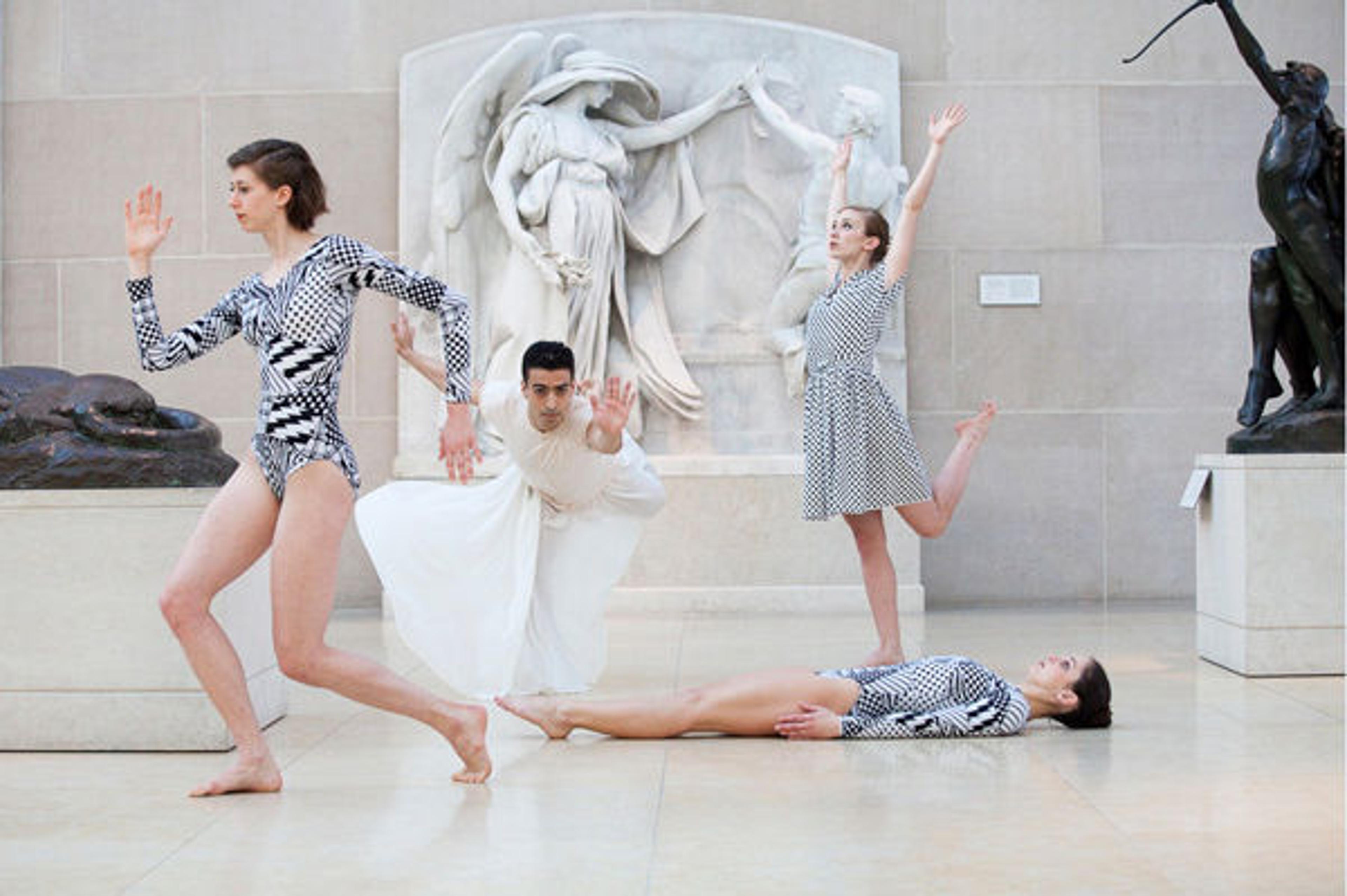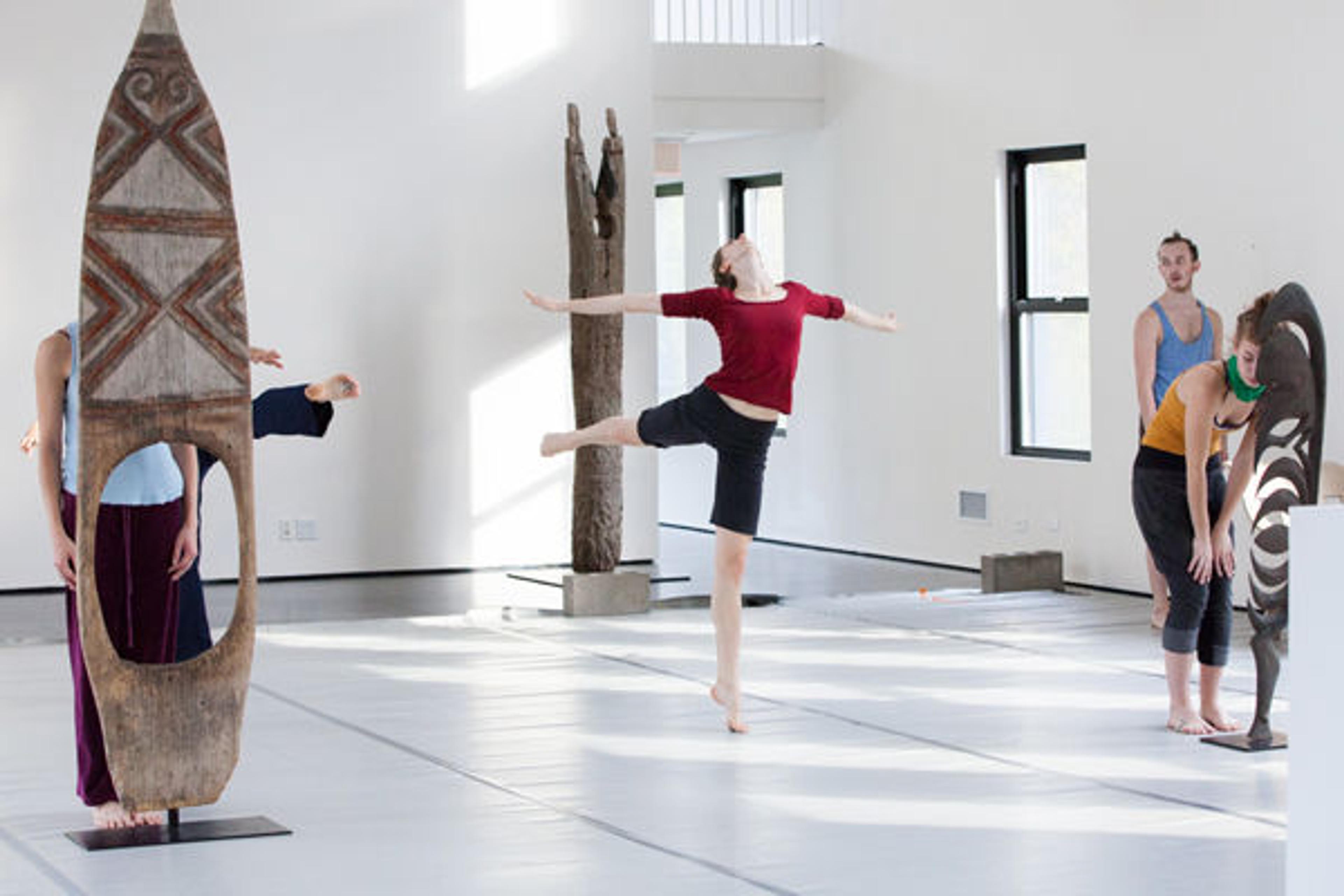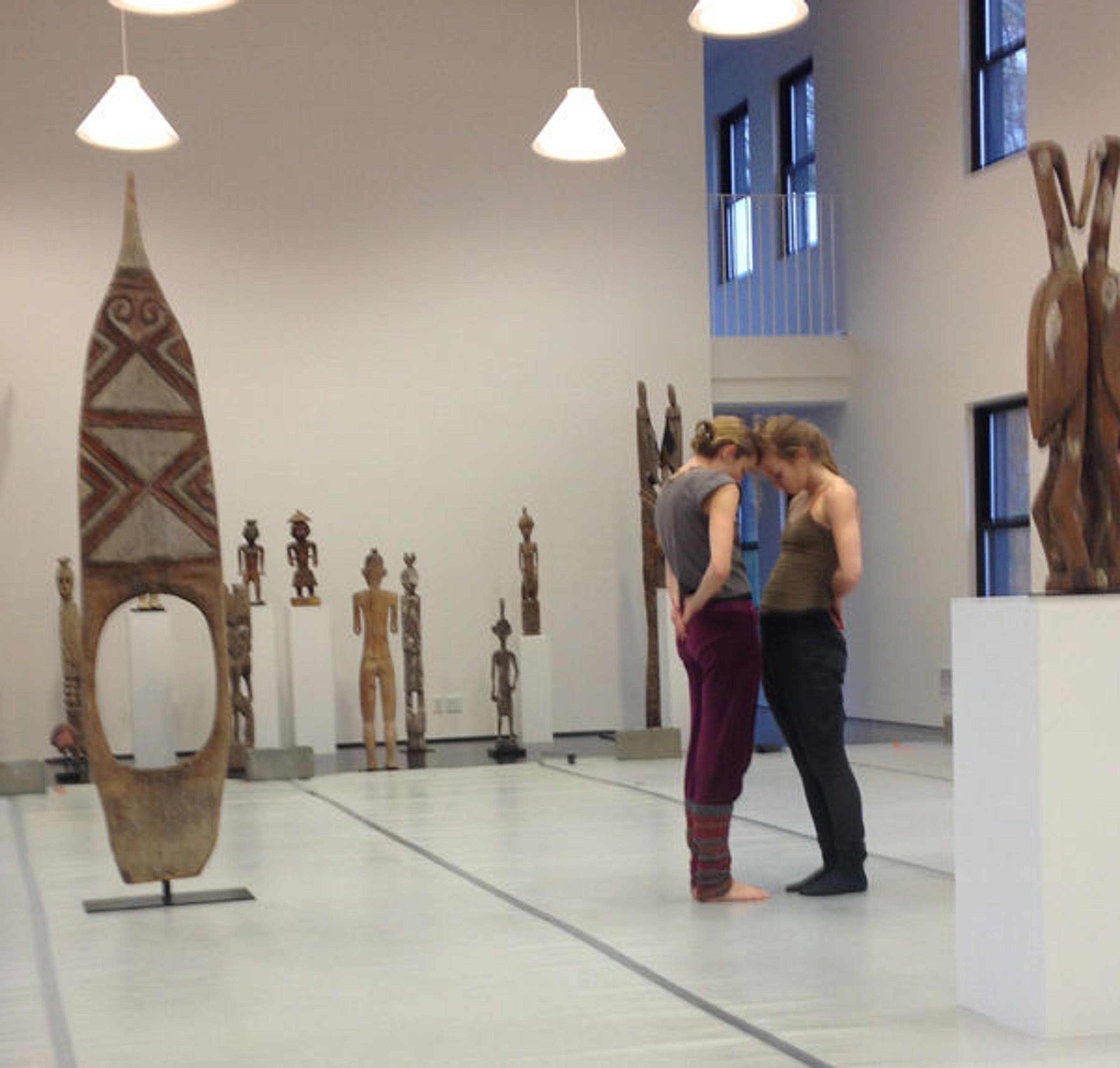Dance Heginbotham and Alarm Will Sound Premiere Site-Specific Fly By Wire at the Met

Dance Heginbotham in the Museum's Charles Engelhard Court. Photograph by Rebecca Greenfield
«Three days into a weeklong series of rehearsals, choreographer John Heginbotham had already created seven minutes of choreography for Fly By Wire, a ten-minute, site-specific performance that will premiere at the Metropolitan Museum on February 20. The piece will be a highlight of the evening-length program Twinned, and will be performed in the Museum's Charles Engelhard Court by his young company, Dance Heginbotham, alongside the Met's artists in residence, Alarm Will Sound. The program features an original score by contemporary composer Tyondai Braxton, as well as music by Aphex Twin and Edgard Varèse.»
I recently sat down with Heginbotham, Braxton, and Alan Pierson, Alarm Will Sound's conductor and artistic director, to reflect on the process of creating Fly By Wire.

Dance Heginbotham rehearsing at the Watermill Center in Water Mill, New York. The Watermill Center is a laboratory for performance founded by Robert Wilson as a unique environment for artists from around the world to explore new ideas, living and working together among the extensive collection of art and artifacts. Photograph by Janelle Jones
How collaborative has this process been? Have you been communicating with one another for a while?
Heginbotham: We've been talking a lot about the setup of the show: what's going to be included in it, the order, involving the dancers as musicians, and involving the musicians in movement. [Tyondai Braxton] and I have had conversations which really did influence my way of thinking about it. He said, "I feel like this piece [of music] is very American." When I was listening to it after, I was like, "Oh my God, it's Columbus discovering America, and then it's the Grand Canyon, and then it moves into, what I would consider, infrastructure."
Braxton: You took the ball and ran with it; I love that description. I feel like you've embodied a lot of the spirit in the piece and that's exciting. To be honest, as far as it being a collaborative thing, really it was just me talking about the work. The piece was commissioned for Alarm Will Sound; I knew John and his company were going to do something with it later on. I think it worked from my end more autonomously, where I created the thing and then John creates his thing, and the meeting is just the dialogue between those two ways of working.
Were you inspired by anything when you were writing this piece of music?
Braxton: Oh yeah! I was going through a really big mariachi phase. That's the thing that's so funny; I talk about it being American. There are elements that are, and then there are elements that draw a lot from mariachi, but the hodgepodge of the influences is the thing that I consider American—without saying I drew from an American folk tune or something. But I was listening to a lot of mariachi, a lot of electronic music, and that influenced the structure as far as the way there's this cyclical phrase that keeps getting tripped up. It's just the confluence of different ideas. And it's great to work with both of these guys that are masters in their own right, to watch them interpret and make it great.

Conductor Alan Pierson and composer Tyondai Braxton consult the score to help the dancers understand some of the more difficult counts and musical cues.
Alan, has Alarm Will Sound worked with a dance company before?
Pierson: No, this is, I think, our first time doing that.
Heginbotham: It is, but we have been talking...
Pierson: It's funny because all of us have been working together through different configurations. I conducted Central Market [an orchestral score by Braxton] out in Los Angeles, John and I have been brainstorming a number of projects for years, and John had already choreographed to music by Tyondai and had choreographed two of Alarm Will Sound's recordings. So this is kind of the coming together of all of us.
The recurring theme of the program is electronic music. All the music in the show has its roots in electronica. Even Tyondai's piece, despite its being a piece for acoustic instruments, has its roots in electronic music. [Alarm Will Sound] is playing music and Dance Heginbotham is dancing, but the most collaborative stuff on the program, and the stuff that has been the hardest for us to figure out are these intersections because there are parts on the program where Alarm Will Sound will move and where Dance Heginbotham dancers will be making music.

"Now we know [the music] a little better from the inside, and that will help us understand what the evening is about and what the piece is about."—John Heginbotham
John, how long have you been working on the choreography?
Heginbotham: Only for three days!
So it literally started when you walked into this residency at the Watermill Center?
Heginbotham: Yes, but having said that, I've listened to a MIDI file of the piece and I've listened to the orchestral recording. I mean it's not that I didn't ever think about it before arriving here. And with this residency I do have a goal that I think is achievable, which is that I want to walk out of here having a very clear map of the dance component.
Pierson: What's the process? I mean are you experimenting and giving the dancers ideas? How do you actually choreograph the dance on them?
Heginbotham: [The dancers] take a warm-up class and during that warm-up class I'm in another room making up phrases of movement. Then they finish their class and I walk in and teach them whatever I've been working on.
Pierson: And do you do that to the music?
Heginbotham: Sometimes yes and sometimes no. Sometimes I'm like, "I'm going to teach you a phrase that has no counts and I just want you to do it as fast as you can, and I don't want it to relate to anything you're hearing. Don't listen to the music." Then other times, "You'll hear this melodic line and I want you to follow it exactly and follow this rhythm very completely." And that's how it happens. And then I forget everything and say, "I want you to take part one and mix it with part three."
Braxton: So it's a very modular approach?
Heginbotham: Exactly.
Pierson [to Braxton]: You kind of write that way, don't you?
Braxton: Absolutely. When you create ideas like that, you get more character that you can then dissect, as opposed to feeling like you have to write linearly. So then you can take these isolated bubbles of ideas and mix and match and see which ones work and which you can extend—and which ones can just be boring.
Heginbotham: What I realize about that, too, is that you don't have to decide everything that you're doing in advance. It gives you the opportunity to play around.

"We're in this place [the Watermill Center] where there's so much art all over and one of the great things about the residency and this project is that we've mocked up what the Engelhard Court is going to look like through Robert Wilson's collection, including having the orchestra in place, too."—John Heginbotham
Why did you want to incorporate the dancers into the percussion, the musical aspect of this performance?
Pierson: We've done a number of projects that involve movement and we wanted this to be a real collaboration with Dance Heginbotham. In a way, it's just like symmetry. Obviously, Dance Heginbotham's role is in the movement side of the evening, and Alarm Will Sound's main role is the instrument side of the evening, but Alarm Will Sound is moving and so it only seemed natural that Dance Heginbotham should play some music. The more the evening can be one conception, and the more connected everything can be, the better. So this is part of trying to reach for that and making that holistic approach happen.
Let's talk about the site-specific aspect of the piece. John, as a choreographer, do you approach the work differently knowing that it is going to be site-specific?
Heginbotham: It totally affects everything because the audience will be seated on three sides, plus balcony, plus there are sculptures obstructing view. So I'm trying to take advantage of what can be seen and what can't be seen. And that's also liberating for me because I'm not trying to face everyone front and give a proscenium—I do love a proscenium—but in this case the people on this side are going to get that show and people over here are going to get a different show.
As a choreographer you kind of have to let go of the control a little bit, right?
Heginbotham: Yes, let go a little bit, but also the music is so precise. And my goal is that ultimately the choreography will also be extremely precise. So the randomizing element is that the audience is wherever they are, seeing very precise structure.

"It's funny, I'm used to the way that I hear it so you kind of forget that a different perspective can change it so dramatically. Watching how it's being interpreted, you just start to see different shades of what you've created, you recontextualize what you've done."—Tyondai Braxton
Purchase Tickets
Fly By Wire will premiere on Thursday, February 20, at 7:00 p.m. as part of the evening-length program Twinned.
Meryl Cates
Meryl Cates is a senior publicist in the Communications Department.